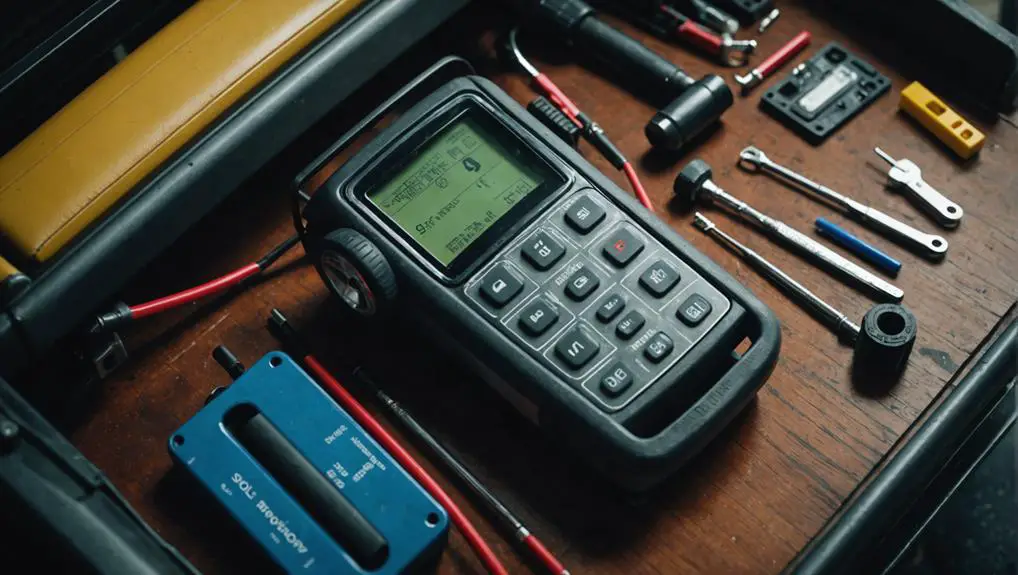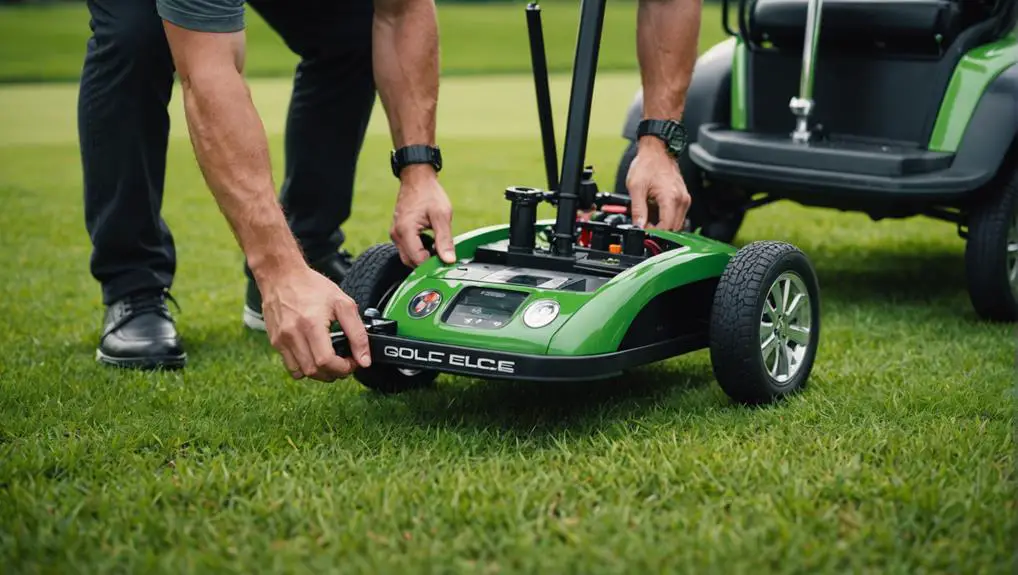Like a sudden stop in a well-rehearsed dance, an electric golf cart's accelerator issues can disrupt your ride. You might notice a delay in response or an unexpected jerk when you press the pedal. To tackle these problems effectively, you'll want to start by examining several key components and understanding what symptoms might indicate deeper issues. The right approach can save you time and money, but there's more to uncover about the essential steps that can get your cart back on track.
Key Takeaways
- Start by checking the battery voltage to ensure it meets manufacturer specifications for optimal performance.
- Inspect the accelerator pedal for obstructions and ensure it moves freely without any damage.
- Examine the throttle assembly and test the potentiometer's resistance with a multimeter against service manual specifications.
- Inspect the wiring harness for loose connections or frayed wires that could impact signal transmission.
- Regularly maintain components by cleaning dirt and debris from the throttle and battery terminals to prevent future issues.
Common Symptoms of Accelerator Issues
When you notice your electric golf cart isn't responding as expected, it's essential to identify the common symptoms of accelerator issues. One of the first signs you might experience is a delayed response when pressing the accelerator pedal. Instead of an immediate reaction, the cart may lag or hesitate before moving.
Additionally, you may find that your cart struggles to reach its normal speed or decelerates unexpectedly while driving.
Another symptom to watch for is a complete lack of acceleration; your cart may not move at all, even when you apply pressure to the pedal. You might also notice unusual noises, such as clicking or grinding sounds, which can indicate a problem within the accelerator mechanism.
Furthermore, the cart could exhibit erratic acceleration, surging forward or slowing down without any input from you.
Key Components to Inspect
Diagnosing accelerator issues in your electric golf cart requires a careful inspection of several key components.
Start with the accelerator pedal itself. Check for any physical obstructions or damage. Confirm it moves freely and isn't stuck or broken.
Next, examine the throttle cable or electronic throttle sensor, depending on your cart's system. Look for fraying, kinks, or corrosion, which can impede function. If your cart uses a potentiometer, test its resistance with a multimeter to verify it's within the manufacturer's specifications.
Don't overlook the controller. Inspect the connections and wiring for signs of wear or damage. A malfunctioning controller can disrupt signals between the pedal and the motor, leading to erratic behavior.
Step-by-Step Troubleshooting Guide

To effectively troubleshoot accelerator problems in your electric golf cart, begin by gathering the necessary tools, including a multimeter and basic hand tools.
Start by checking the battery voltage to verify it's within the manufacturer's specified range. If the voltage is low, recharge or replace the batteries.
Next, inspect the accelerator pedal and its linkage. Confirm there are no obstructions and that the pedal moves freely.
Then, check the throttle assembly for any signs of wear or damage. Use the multimeter to measure the resistance across the throttle. Compare your findings with the specifications in your cart's service manual.
After that, examine the wiring harness for loose connections or frayed wires. Pay close attention to connections at the controller and motor.
If you find any issues, repair them as needed.
Repairing or Replacing Faulty Parts
If you've identified faulty components during your troubleshooting, addressing them promptly is vital to restoring your electric golf cart's performance. Start by isolating the specific part that's malfunctioning. Common culprits include the accelerator pedal assembly, speed controller, wiring connections, and batteries.
For the accelerator pedal assembly, inspect it for any signs of wear or damage. If you find issues, you may need to replace it entirely. Make sure you disconnect the battery before starting the replacement process to avoid electrical shock.
Next, check the speed controller. If it's not responding correctly, test its connections and replace it if necessary. A faulty speed controller can lead to inconsistent acceleration, making it critical for safety and performance.
Examine all wiring connections for corrosion or loose fittings. Clean and tighten any connections to guarantee proper conductivity. If you notice damaged wires, replace them immediately to prevent further complications.
Lastly, assess your batteries. Weak or failing batteries can affect overall performance. Test their voltage and replace any that fall below the recommended level.
Preventive Maintenance Tips

Maintaining your electric golf cart can greatly reduce the likelihood of encountering accelerator problems in the future. Start by regularly inspecting the throttle and accelerator pedal for dirt or debris. Clean these components with a soft cloth to guarantee they function smoothly.
Next, check the connections of the accelerator wire harness. Loose or corroded connections can lead to erratic behavior. Tighten any loose connectors and apply dielectric grease to prevent corrosion.
Battery maintenance is also essential. Keep the battery terminals clean and free of corrosion. Regularly check the water levels in the batteries and top off with distilled water when necessary, guaranteeing peak performance.
Inspect the motor and controller for any signs of wear or damage. Look for frayed wires or burnt connectors, as these can lead to serious issues.
Frequently Asked Questions
Can Weather Conditions Affect Electric Golf Cart Accelerator Performance?
Yes, weather conditions can affect electric golf cart accelerator performance. High humidity can cause moisture buildup in electrical components, leading to erratic acceleration.
Conversely, extreme cold can reduce battery efficiency, impacting how quickly your cart responds to accelerator input. Hot weather may overheat the motor, causing it to throttle down.
Always monitor weather conditions and guarantee your cart's components are properly maintained to optimize performance in varying climates.
How Often Should I Check My Golf Cart's Battery Connections?
You mightn't realize it, but ignoring your golf cart's battery connections could lead to unexpected issues. You should check them regularly, ideally every month, to guarantee they're tight and free of corrosion.
A loose or corroded connection can cause performance problems, leaving you stranded on the course. During seasonal changes, increase your checks to every couple of weeks.
Staying proactive keeps your cart running smoothly and avoids inconvenient surprises when you're ready to ride.
Is It Safe to Drive With a Faulty Accelerator?
Driving with a faulty accelerator isn't safe. It can lead to unpredictable speed changes, making it difficult to control the cart.
You're risking not only your safety but also that of others around you. If you notice any issues, like delayed response or erratic acceleration, it's essential to address them immediately.
Always prioritize safety and have a professional inspect the accelerator before you continue using the golf cart.
What Tools Do I Need for Accelerator Troubleshooting?
To troubleshoot an accelerator issue, you'll need several essential tools.
Start with a multimeter for measuring voltage and continuity, which helps identify electrical problems.
A screwdriver set will assist in accessing various components, while pliers and wire cutters are vital for handling wires.
A diagnostic scanner can provide deeper insights into electronic systems.
How Can I Improve My Golf Cart's Overall Performance?
To improve your golf cart's overall performance, start by ensuring the battery is fully charged and in good condition.
Regularly clean the battery terminals and connections to prevent corrosion.
Check the tire pressure, as properly inflated tires enhance efficiency.
Upgrading to a high-performance controller can also boost speed and acceleration.
Conclusion
In summary, effectively diagnosing and fixing electric golf cart accelerator problems is essential for maintaining performance and safety. Notably, studies show that up to 30% of electric golf cart issues stem from accelerator malfunctions, emphasizing the importance of regular inspections. By closely monitoring key components and performing preventive maintenance, you can greatly reduce the likelihood of future problems. Staying proactive guarantees your golf cart operates smoothly, enhancing both your enjoyment and the longevity of the vehicle.